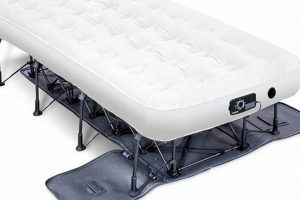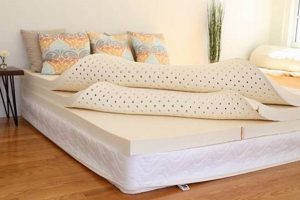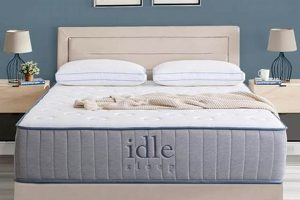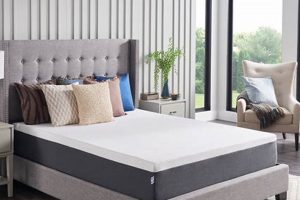Selecting appropriate bedding for elevated sleeping platforms necessitates careful consideration. The goal is to find a sleeping surface that prioritizes both safety and comfort for the user in the constrained space of a bunk. This choice is vital for promoting restful sleep and minimizing potential hazards.
The importance of proper bedding selection in bunk setups extends beyond mere comfort. A well-chosen sleeping surface contributes to a safe environment, preventing falls and ensuring adequate support. Historically, inadequate bedding has been a contributing factor in bunk-related injuries, making informed decisions paramount.
The following sections will delve into key considerations for selecting suitable bedding, including mattress type, thickness limitations, safety standards, and the impact on overall sleep quality within the specific context of elevated beds.
Essential Guidance for Selecting Bunk Bed Mattresses
The selection of an appropriate sleeping surface for bunk configurations demands careful attention to several key factors. Prioritizing safety, comfort, and durability is crucial for ensuring a positive sleeping experience.
Tip 1: Height Restriction Awareness: Bunk beds often have specified maximum mattress heights. Adhering to these restrictions prevents exceeding the guardrail height, minimizing the risk of falls. Consult the bunk bed manufacturer’s guidelines for specific height recommendations.
Tip 2: Prioritize Safety Standards: Seek mattresses that meet or exceed relevant safety standards, such as those related to flammability and material composition. Certifications from reputable organizations indicate independent testing and compliance.
Tip 3: Consider Mattress Type: Options include innerspring, memory foam, and hybrid models. Innerspring mattresses offer traditional support, while memory foam contours to the body. Hybrid models combine both for a balance of support and comfort. Evaluate the specific needs of the user when making this determination.
Tip 4: Focus on Proper Support: Adequate support is vital for maintaining spinal alignment and preventing discomfort. Firmer mattresses are generally recommended for stomach sleepers, while softer options may be preferred by side sleepers. Consider the sleeper’s preferred position when assessing support.
Tip 5: Evaluate Weight Capacity: Ensure the selected mattress is rated to support the weight of the intended user. Exceeding the weight capacity can compromise the mattress’s structural integrity and potentially lead to premature wear or failure.
Tip 6: Material Quality and Durability: Opt for mattresses constructed from high-quality materials known for their durability. Look for features such as reinforced edges or durable fabric covers that can withstand the rigors of bunk bed use. A durable mattress ensures longevity and consistent performance.
Selecting a mattress that addresses these critical considerations can lead to improved sleep quality, enhanced safety, and a more positive experience for bunk bed users. A thoughtful approach to this decision is a worthwhile investment in well-being.
The subsequent sections will explore specific mattress types in greater detail, providing additional insight into making an informed purchase.
1. Height Restriction
Height restriction is a critical element in determining the suitability of a sleeping surface for bunk beds. It directly impacts the safety and functionality of the bunk bed setup, necessitating careful consideration during the selection process.
- Guardrail Effectiveness
Adhering to prescribed height limitations ensures the guardrail adequately protects the occupant from accidental falls. If a mattress exceeds the recommended height, the guardrail’s protective function is compromised, increasing the risk of injury, particularly during sleep. Manufacturers specify maximum mattress heights to maintain guardrail efficacy.
- Ladder Accessibility
Excessive mattress thickness can impede access to the upper bunk via the ladder. A mattress that is too thick reduces the available space between the top of the mattress and the ladder rungs, making climbing more difficult and potentially hazardous. This issue is particularly relevant for younger users.
- Headroom Considerations
In the lower bunk, headroom can be significantly reduced if the upper bunk mattress is excessively thick. This can create a cramped and uncomfortable environment, potentially impacting sleep quality and overall comfort. Assessing headroom availability is crucial, especially for adults using the lower bunk.
- Structural Integrity
While less direct, excessively thick mattresses can place undue stress on the bunk bed frame, particularly if the combined weight of the mattress and occupant exceeds the structure’s design capacity. This can lead to long-term structural issues and potential safety hazards. Adhering to weight and dimension specifications is essential.
The relationship between height restriction and bedding selection for bunk beds underscores the paramount importance of adhering to manufacturer specifications. Choosing a mattress that complies with height limitations directly contributes to a safer, more comfortable, and structurally sound bunk bed environment.
2. Support and Comfort
The interplay between support and comfort forms a cornerstone in determining the suitability of bedding for bunk configurations. Adequate support ensures proper spinal alignment, mitigating the risk of back pain and discomfort, particularly crucial given the often-restricted movement space within a bunk. Simultaneously, comfort considerations, such as pressure relief and temperature regulation, are essential for promoting restful sleep. The ideal bunk surface provides a balance between these two elements, creating a sleep environment conducive to both physical well-being and restorative rest.
Insufficient support can manifest in several ways, including the development of pressure points, particularly in the shoulders and hips, leading to disrupted sleep patterns. Conversely, an overly firm surface, while offering substantial support, may lack the necessary conforming properties to alleviate pressure, resulting in discomfort. For instance, a child using a thin innerspring on the top bunk might experience pressure point pain, while an adult on the lower bunk might find an overly soft memory foam mattress unsupportive, leading to back strain. The selection process, therefore, must account for individual sleep preferences, body weight, and sleeping positions to optimize both support and comfort.
Achieving the optimal balance between these elements necessitates a careful evaluation of mattress materials, construction, and design. Hybrid mattres
ses, combining the support of innerspring coils with the comfort of memory foam or latex layers, often represent a viable solution. Ultimately, the efficacy of a selected surface for a bunk bed hinges on its ability to deliver appropriate support while simultaneously promoting a comfortable and restful sleep experience. Neglecting either aspect can negatively impact the user’s well-being and overall satisfaction with the bunk bed arrangement.
3. Material Durability
Material durability constitutes a critical factor in evaluating bedding intended for bunk configurations. The longevity and performance of the sleeping surface are directly tied to the quality and resilience of its constituent materials, making this a primary consideration for sustained comfort and safety.
- Foam Density and Resilience
Foam density, measured in pounds per cubic foot (PCF), significantly impacts a memory foam or polyfoam mattress’s ability to withstand repeated use. Higher density foams generally exhibit greater resistance to compression and sagging, extending the usable lifespan of the product. For example, a low-density foam mattress may develop indentations or lose its supportive properties prematurely, particularly under the weight of an adult. This is especially relevant in bunk bed scenarios where mattresses may experience concentrated weight distribution.
- Coil Gauge and Construction
In innerspring and hybrid mattresses, the coil gauge and construction method directly affect durability. Lower gauge numbers indicate thicker, more robust coils that are less prone to deformation or breakage. Furthermore, features such as individually wrapped coils can enhance durability by minimizing motion transfer and preventing coil entanglement, issues that can accelerate wear. Consider, for example, a scenario where a bunk bed is frequently used by children; a mattress with a lower coil gauge is likely to withstand the increased activity and weight fluctuations more effectively.
- Fabric Cover Strength and Abrasion Resistance
The mattress cover’s strength and abrasion resistance are essential for protecting the internal components from damage and wear. High-quality fabrics, such as tightly woven polyester blends, exhibit superior resistance to tearing, staining, and abrasion. Conversely, thinner or more loosely woven fabrics are more susceptible to damage, potentially compromising the integrity of the underlying materials. For instance, a bunk mattress with a durable cover is better equipped to withstand the friction and abrasion associated with frequent climbing and movement.
- Seam Construction and Reinforcement
The quality of seam construction and the presence of reinforcement features, such as reinforced edges or handles, contribute significantly to overall durability. Well-constructed seams prevent the separation of fabric panels, while reinforced edges provide additional support and prevent sagging or deformation along the mattress perimeter. These features are particularly important in bunk beds, where mattresses are often subjected to greater stress along the edges due to limited space and frequent ingress and egress.
The selection of a sleeping surface for bunk configurations necessitates careful attention to material durability. A mattress constructed from high-quality, resilient materials will provide sustained comfort, support, and safety, ensuring a worthwhile investment for long-term use. These considerations should be factored into any determination of an optimal bedding solution, ensuring it is not merely comfortable but also built to withstand the demands of bunk bed usage.
4. Safety Standards
Adherence to established safety standards constitutes an indispensable aspect of selecting appropriate bedding for bunk configurations. These standards, developed by regulatory bodies and industry organizations, aim to minimize potential hazards and ensure a safe sleep environment. Their implementation is critical in mitigating risks associated with flammability, material toxicity, and structural integrity, thereby safeguarding the well-being of bunk bed occupants.
- Flammability Regulations
Flammability regulations, such as those outlined in 16 CFR Part 1633 (Standard for the Flammability (Open Flame) of Mattress Sets), mandate that mattresses meet specific resistance criteria to open flame ignition. Non-compliant bedding can rapidly ignite, posing a significant fire hazard. Compliance ensures that the mattress will self-extinguish or burn slowly, providing valuable time for occupants to evacuate in the event of a fire. This is especially important in bunk bed scenarios, where escape routes may be limited.
- Material Composition and Toxicity
Stringent standards govern the permissible levels of potentially harmful chemicals and substances in mattress materials. Certifications like CertiPUR-US indicate that the foam used in the mattress has been independently tested and certified to meet specific criteria for emissions, content, and durability. These certifications assure consumers that the bedding does not contain harmful levels of substances such as formaldehyde, heavy metals, or phthalates, minimizing the risk of adverse health effects, particularly for children who may be more susceptible to chemical exposure.
- Structural Integrity and Stability
While specific standards addressing mattress structural integrity in the context of bunk beds are less prevalent, adherence to general mattress manufacturing guidelines indirectly promotes stability. These guidelines often address factors such as edge support and coil construction, which contribute to the overall stability and prevent premature sagging or deformation. A structurally sound mattress maintains its shape and supportiveness over time, reducing the risk of falls or injuries associated with uneven sleeping surfaces.
- Height and Dimension Compliance
Although not a safety standard in the strictest sense, adherence to manufacturer-specified height and dimension limitations is crucial for ensuring the safe operation of bunk beds. Exceeding the recommended height can compromise the effectiveness of guardrails, increasing the risk of falls. Similarly, using a mattress that is too wide or long can interfere with the ladder or other safety features. Compliance with these specifications ensures that the mattress integrates seamlessly with the bunk bed structure, maximizing safety and functionality.
The integration of these safety standards into the selection process is fundamental to establishing a secure sleep environment within bunk configurations. Prioritizing compliance with flammability regulations, material toxicity limits, structural integrity guidelines, and dimensional specifications ensures that the chosen bedding minimizes potential risks and promotes the well-being of all occupants. The absence of such considerations can render even a seemingly comfortable and supportive mattress unsuitable for a bunk setting.
5. Weight Capacity
Weight capacity represents a pivotal consideration when selecting b
edding for bunk configurations. It directly correlates with the mattress’s ability to provide adequate support, maintain its structural integrity, and ensure user safety. Exceeding the specified weight limit can compromise the mattress’s performance, potentially leading to premature wear, sagging, and an increased risk of injury. A mattress designed to support a maximum weight of 200 lbs, for example, will likely exhibit diminished support and accelerated degradation when subjected to a consistent load exceeding that limit. This is particularly relevant in bunk bed scenarios where the upper bunk may be used by older children or adults.
The consequences of disregarding weight capacity extend beyond mere discomfort. A mattress subjected to excessive weight may experience internal structural damage, such as broken coils or compressed foam layers. This damage can compromise the mattress’s ability to distribute weight evenly, creating pressure points and potentially leading to back pain or other musculoskeletal issues. Furthermore, a structurally compromised mattress may become unstable, increasing the risk of falls, especially for occupants of the upper bunk. Consider a situation where a family purchases a low-cost, low-density foam mattress with a limited weight capacity for a growing teenager; over time, the mattress may develop significant sagging, creating an uneven sleeping surface and increasing the risk of the occupant rolling off the bed during sleep.
Therefore, a thorough evaluation of weight capacity, in conjunction with other factors such as height restrictions and safety standards, is essential for selecting bedding suited for bunk use. Manufacturers typically specify the maximum weight capacity clearly on the product label or in the accompanying documentation. Consulting these specifications and ensuring that the selected bedding can adequately support the intended user is a crucial step in promoting a safe and comfortable sleep environment. Ignoring this element can have direct negative implications for the user’s well-being and the longevity of the bedding itself.
Frequently Asked Questions
This section addresses common inquiries regarding appropriate bedding choices for bunk bed configurations, emphasizing safety, comfort, and compliance with relevant standards.
Question 1: What mattress thickness is permissible for bunk configurations?
Thickness limitations are dictated by the bunk frame manufacturer to ensure guardrail effectiveness. Exceeding the specified maximum thickness compromises the guardrail’s protective function and elevates the risk of falls. Refer to the bunk’s documentation for precise specifications.
Question 2: What mattress type is most suitable for a bunk setup?
The ideal selection depends on individual preferences, but considerations such as weight, sleeping position, and height restrictions guide the decision. Low-profile memory foam, innerspring, or hybrid models that meet height constraints are often viable options. Assess firmness and support based on the intended user.
Question 3: How significant is flammability compliance in mattress selection?
Flammability compliance is paramount. Bedding must meet or exceed established flammability standards to minimize the risk of fire-related hazards. Verify compliance with regulations such as 16 CFR Part 1633 to ensure occupant safety.
Question 4: Does mattress weight capacity have implications for bunk beds?
Weight capacity is a crucial factor. Exceeding the specified weight limit can compromise the mattress’s structural integrity and lead to premature wear or failure. Ensure that the selected bedding is rated to support the intended user’s weight.
Question 5: Are there specific mattress certifications to seek for bunk beds?
Certifications such as CertiPUR-US indicate that the foam components have been independently tested for emissions, content, and durability. These certifications provide assurance regarding the mattress’s composition and potential health impacts.
Question 6: How should one address support concerns for upper bunk occupants?
Adequate support is critical, particularly for upper bunk users. Select a mattress that provides sufficient spinal alignment and pressure relief to prevent discomfort or musculoskeletal issues. Consider firmer options or models with enhanced edge support.
In summary, selecting appropriate bedding for bunk arrangements requires careful attention to safety, compliance, and user-specific needs. Adherence to established standards and thoughtful consideration of these factors contribute to a secure and comfortable sleep environment.
The following section will address common misconceptions regarding bunk bedding selection.
Concluding Remarks
The preceding analysis has underscored the multifaceted considerations inherent in selecting a suitable sleeping surface for bunk configurations. Critical factors such as height restrictions, safety standard compliance, material durability, and weight capacity directly influence the overall utility and safety of bedding choices. Optimal selection involves a careful evaluation of these elements, ensuring the chosen bedding promotes both safety and restful sleep within the constraints of bunk arrangements. The appropriate selection yields not only physical comfort but also an assurance of a secure sleeping environment.
In conclusion, a strategic approach to selecting the best mattress for bunk beds constitutes a fundamental element in establishing a safe and functional sleeping space. Continued awareness and adherence to relevant guidelines will contribute to maximizing the benefits and minimizing the risks associated with bunk bed use. Future advancements in material science and mattress design may offer even more refined solutions, but the core principles of safety and suitability will remain paramount.






![Top-Rated: Best Foam Mattress for Camping - [Year] Guide Organic & Natural Mattress Buyer’s Guide: Non-Toxic Sleep Solutions Top-Rated: Best Foam Mattress for Camping - [Year] Guide | Organic & Natural Mattress Buyer’s Guide: Non-Toxic Sleep Solutions](https://mattressworldpa.com/wp-content/uploads/2025/07/th-7661-300x200.jpg)
